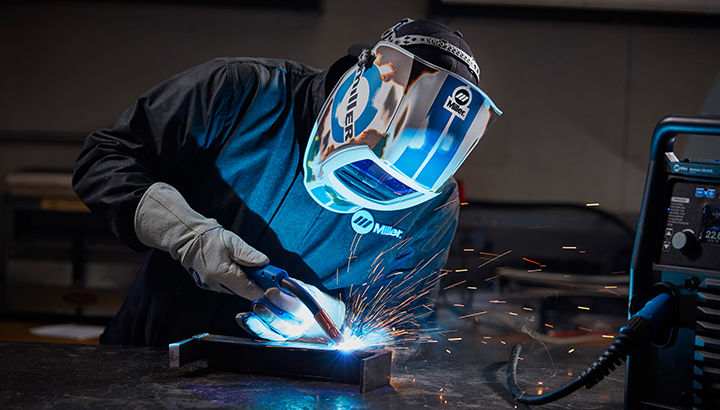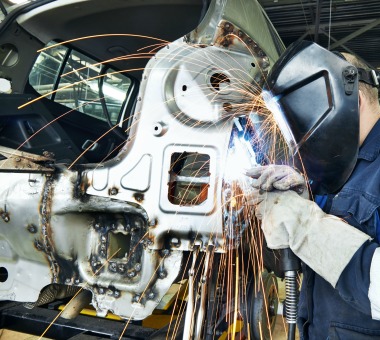Belgrade Fabrication’s proven methods for dealing with incomplete fusion
Wiki Article
Usual Welding Fixing Issues and How to Address Them Properly
Welding repair services frequently run into a variety of concerns that can threaten the honesty of the last item. Common problems consist of insufficient penetration, porosity, and imbalance, to name a few. Each flaw provides special challenges that require specific approaches for resolution. Recognizing these concerns is important for welders aiming to improve their abilities and results. This discussion will certainly discover these common welding repair work issues and effective methods to resolve them.Poor Infiltration
Insufficient penetration happens when the weld metal falls short to totally fuse with the base product, causing weak joints and potential architectural failures. This issue usually originates from not enough warm input, wrong electrode angle, or incorrect welding speed. Welders might come across inadequate penetration due to a miscalculation of the essential criteria for a particular material density or type. Furthermore, contamination on the base material's surface can hinder reliable bonding, exacerbating the issue. To deal with inadequate infiltration, welders should guarantee appropriate settings on their tools and maintain a clean job surface. Routine evaluation of welds is recommended to identify any type of deficiencies early, enabling for prompt corrections and the prevention of endangered structural stability in welded assemblies.Porosity
Porosity is a common issue in welded joints that shows up as small gas bubbles trapped within the weld metal. This defect can endanger the honesty of the weld, leading to minimized toughness and prospective failing under tension. Montana Mobile Welding and Repair Belgrade Welding. Porosity normally emerges from contamination, moisture, or improper welding techniques, which permit gases to escape into the molten weld swimming pool. To resolve porosity, welders must assure appropriate surface area preparation, keep a clean functioning environment, and utilize ideal welding criteria. Additionally, picking the right filler material and shielding gas can mitigate gas entrapment. Regular assessment and testing of welds can assist identify porosity early, guaranteeing prompt restorative actions are taken, thus protecting the quality and reliability of the welded structureImbalance
Imbalance in welding can occur from different aspects, including incorrect configuration and thermal expansion. Comprehending the source is crucial for efficient resolution. Several adjustment methods are available to realign elements and ensure structural integrity.Reasons for Imbalance
Welding imbalance frequently comes from a variety of underlying concerns that can jeopardize structural honesty. One key cause is inappropriate fit-up of components prior to welding, which can cause spaces and irregular surface areas. Variants in thermal expansion during the welding procedure can also result in distortion, specifically if the products being joined have various coefficients of expansion. In addition, inadequate fixturing and securing might stop working to hold elements securely in place, leading to movement throughout welding. Poorly conserved devices, including welding machines and tools, might present disparities in the weld bead, further adding to misalignment. Lastly, driver mistake, stemming from insufficient training or experience, can likewise play a significant function in creating misaligned welds.Improvement Methods Offered
Dealing with imbalance properly calls for a combination of rehabilitative techniques customized to the specific concerns at hand. One common technique is the usage of components or jigs to hold components in the appropriate position throughout welding, making sure consistent positioning. In addition, preheating the materials can help in reducing distortion and boost fit-up. For considerable imbalance, mechanical adjustment strategies, such as using hydraulic jacks or clamps, can be utilized to deal with the placement before welding. Post-weld warmth therapy might likewise be necessary to soothe anxieties triggered by imbalance. Lastly, careful inspection and adjustment throughout the setup stage can protect against imbalance problems from ending up being substantial problems, advertising a smoother welding process and boosting general structural stability.Distortion
Distortion is a typical difficulty in welding that can arise from various aspects, consisting of irregular heating & cooling. Recognizing the reasons of distortion is crucial for executing effective prevention techniques. Resolving this concern not only boosts structural stability however additionally improves the overall high quality of the weld.Root causes of Distortion
When based on the extreme warm of welding, materials often undertake modifications that can bring about distortion. This sensation primarily occurs from thermal growth and contraction during the welding procedure. As the weld area warms up, the material expands; upon cooling, it contracts, which can produce interior anxieties. Additionally, uneven heating throughout a workpiece can aggravate these stress and anxieties, leading to bending or bending. The sort of product likewise plays a significant role; metals with differing thermal conductivity and coefficients of expansion might react in a different way, causing uncertain distortions. Bad joint design and inadequate fixturing can add to imbalance throughout welding, enhancing the possibility of distortion. Understanding these reasons is necessary for effective welding repair work and avoidance approaches.Prevention Techniques
Reliable prevention methods for distortion throughout welding emphasis on regulating warm input and making sure proper joint style. Preserving a regular heat input helps to lessen thermal growth and contraction, which can lead to distortion. Using strategies such as pre-heating the workpiece can additionally lower the temperature slope, advertising uniform home heating. In addition, choosing suitable joint layouts, such as T-joints or lap joints, can enhance stability and lower anxiety focus. Carrying out proper fixturing to safeguard the workpieces in location further help in maintaining positioning throughout the welding procedure. Lastly, staggered welding series can distribute heat more equally, protecting against localized distortion. By using these techniques, welders can considerably lower the possibility of distortion and enhance the overall top quality of their welds.Fracturing
Splitting is a typical problem experienced in welding fixings, commonly resulting from numerous variables such as inappropriate air conditioning prices, stainless steel flux core wire material selection, or insufficient joint prep work. The incident of fractures can considerably compromise the integrity of the weld, bring about potential failures during operation. To address this concern, welders need to initially assess the source, ensuring that materials are compatible and appropriately picked for the particular application. Additionally, controlling the air conditioning rate during the welding procedure is crucial; fast cooling can cause stress and bring about cracking. Proper joint design and preparation additionally add to minimizing the danger. Executing these approaches can improve weld top quality and toughness, eventually minimizing the chance of splitting in ended up weldments.
Insufficient Combination
A considerable concern in welding repair work is incomplete fusion, which happens when the weld steel does not effectively bond with the base material or previous weld passes - Belgrade Welding. This issue can result in weaknesses in the joint, possibly endangering the integrity of the bonded structure. Aspects adding to insufficient fusion consist of insufficient heat input, incorrect welding method, and contamination of the surface areas being signed up with. To resolve this problem effectively, welders ought to assure appropriate pre-weld cleaning and surface area prep work, in addition to change their welding parameters to achieve appropriate penetration and blend. Normal examination during the welding process can also assist recognize incomplete combination early, enabling timely restorative steps to boost the total high quality of the weldOverheating
While welding fixings can improve architectural honesty, overheating provides a considerable challenge that can result in material deterioration. Extreme warmth throughout welding can alter the mechanical properties of metals, causing decreased strength, enhanced brittleness, and warping. This phenomenon is particularly important in high-stress applications where architectural reliability is critical. Recognizing getting too hot can involve aesthetic evaluations for staining or distortion, in addition to keeping track of temperature level throughout the welding procedure. To alleviate the dangers associated with overheating, welders need to use proper methods, such as managing warmth input, changing travel rate, and using suitable filler products. Furthermore, implementing pre- and post-weld heat therapies can aid bring back material properties and enhance the total quality of the repair work, making certain long-term efficiency and safety.Frequently Asked Concerns
What Are the Common Indications of a Welding Problem?

Just How Can I Test My Welds for Top quality?
To examine welds for top quality, one can use aesthetic assessments, ultrasonic see this site testing, and radiographic approaches. Each technique assures architectural honesty, recognizes defects, and verifies adherence to specified criteria, ultimately enhancing the integrity of the bonded joints.What Security Precautions Should I Take While Welding?
When welding, one need to prioritize security by wearing suitable individual safety equipment, making sure correct air flow, protecting combustible materials away, maintaining a clean workspace, and being conscious of surroundings to stop injuries and accidents.Can I Repair a Weld Without Remodeling the Entire Joint?
Fixing a weld without renovating click for info the whole joint is possible, depending on the damage (Montana Mobile Welding and Repair Belgrade Welding). Techniques such as grinding, adding filler product, or utilizing a welding procedure can effectively address specific imperfections while protecting the bordering structureWhat Tools Are Necessary for Efficient Welding Repair Works?
Vital tools for effective welding repair services include a welding maker, wire brush, grinder, safety equipment, clamps, and filler products. Each device plays an essential role in ensuring high quality and safety throughout the fixing process. Porosity commonly occurs from contamination, dampness, or inappropriate welding strategies, which allow gases to run away right into the molten weld swimming pool. Badly conserved tools, including welding equipments and tools, may introduce variances in the weld grain, additional contributing to imbalance. When subjected to the intense heat of welding, materials usually undergo adjustments that can lead to distortion. Cracking is an usual problem come across in welding repairs, frequently resulting from numerous elements such as incorrect cooling prices, product option, or poor joint prep work. A substantial issue in welding repairs is incomplete blend, which happens when the weld steel does not properly bond with the base product or previous weld passes.Report this wiki page